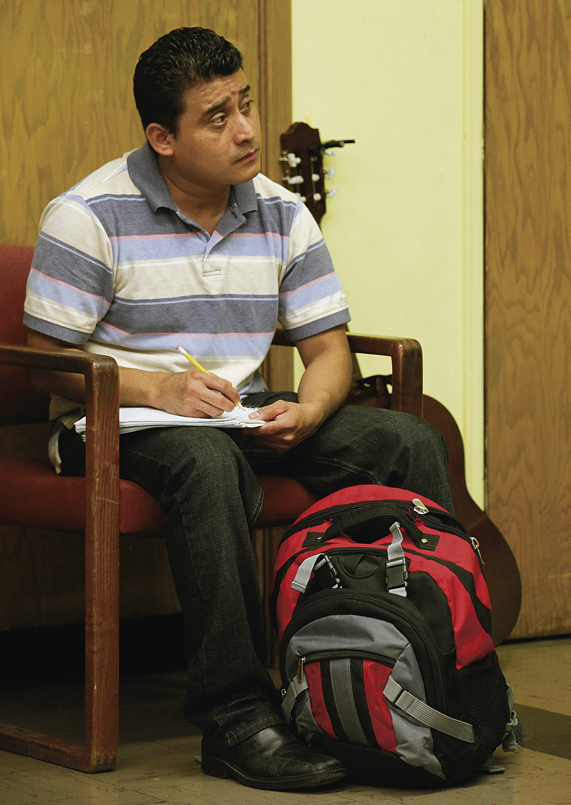by Patricia Zapor

WASHINGTON (CNS) – The first days for applying for deferred deportation for some young adults under a program to use prosecutorial discretion brought out tens of thousands of applicants to workshops around the country and a first wave of responses from state governments about what privileges they would and would not extend to the recipients.
In Chicago, an estimated 13,000 people lined up at the Navy Pier to get information and apply for deferred deportation status for 15- to 30-year-olds Aug. 15, the first day applications could be filed under a move announced by President Barack Obama in June.
Embassies and consulates around the country had long lines of people seeking documents they might need to apply. Church-run service agencies such as Guadalupe Social Services in the Diocese of Venice, Fla., reported steady calls and full schedules of appointments from people seeking help figuring out the program, known as Deferred Action for Childhood Arrivals, or DACA.
Lindsay Spinazzola, immigration counselor for Guadalupe Social Services, said she’s maxed out at three appointments a day for the next few weeks to help people figure out if they can participate in the program.
“I get about 10 calls a day,” she said, noting that she’s a one-person operation for immigration cases at Guadalupe, which is in Naples, Fla. A much larger nonprofit legal aid organization in the area is handling most calls, she told Catholic News Service Aug. 20. “There’s a huge training program being held tonight,” she said.
Spinazzola said about half of the queries she gets are for people who clearly cannot participate in the program, at least not yet, because they involve applications for children who are younger than 15. DACA is open to people who arrived in the United States before age 16, have been here at least five years and were not yet age 31 by June 15, when the program was announced. People younger than 15 who otherwise qualify will be able to apply once they reach age 15, the government announced.
Still evolving a week after the program launched was information about how individual states would treat recipients of the status. It’s expected that it will take a couple of months or more before the first approved participants have completed the process and received their documents.
In Phoenix, Arizona Gov. Jan Brewer issued an executive order saying beneficiaries of the federal status would not be eligible for driver’s licenses, in-state tuition rates, or even be allowed to attend state-sponsored GED classes for the high school-equivalency exam. Enrollment in a GED program is one element that can be used to show eligibility for the program.
Nebraska Gov. Dave Heineman also issued a statement saying licenses and in-state tuition would continue to be off-limits to deferred action participants.
But California and Oregon announced that the federal work permit which comes along with the deferred action status would qualify as evidence of lawful status, meaning people with the permits can apply for driver’s licenses.
Texas Gov. Rick Perry wrote to the state attorney general that the program “does not undermine or change our state laws” and that it would “confer absolutely no legal status whatsoever” on approved participants. However, Texas immigration attorneys point out that a federal work permit is already recognized in the state to prove eligibility for a driver’s license.
In Georgia, which has passed a strict law meant to crack down on undocumented immigrants, the spokeswoman for the Department of Driver Services told CNN that under current law, people with deferred deportation status can get a license.
New Mexico and Washington are the only states that issue drivers’ licenses without proof of legal residency. Utah issues a “driving certificate” to people who cannot prove their legal status. Other states require a Social Security card, which will be issued as part of being approved for work, under DACA. In 28 states, proof of “lawful presence” is required.
U.S. Citizenship and Immigration Services, which is administering the DACA program for most applicants, says in its information that people who receive deferred deportation status do not continue to accrue “unlawful presence,” a factor in admission standards for various kinds of visas, but the agency adds that DACA “does not confer any lawful status.”
Whether DACA participants will be able to go to college at in-state tuition rates was also being settled state-by-state, and sometimes on a school-by-school basis.
Denver’s Metropolitan State University announced earlier this summer that it would extend lower tuition rates to undocumented students who meet other residency requirements, although Colorado bars undocumented students from in-state rates at other state institutions. The rate for undocumented students at Metropolitan State is $3,358 per semester, compared to $7,993 for out-of-state students and $2,152 for in-state students who are U.S. citizens or have legal residency status.
The Education Trust reported that 13 states currently allow undocumented students to attend state schools at the lower tuition rates, while six explicitly prohibit it.
